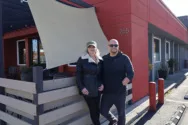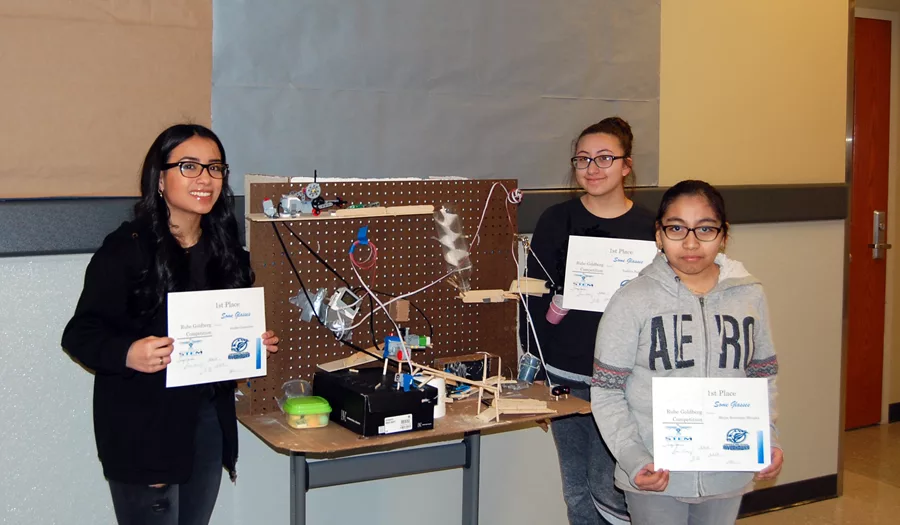
Home » $15,000-plus in STEM Like Me! grants fuel STEM programs in Tri-City schools
$15,000-plus in STEM Like Me! grants fuel STEM programs in Tri-City schools

April 16, 2019
More than $15,000 in STEM education grants are in use at
Tri-City area schools, creating or supporting robotics clubs, aeroponic
gardening and microscopic photography, among other projects.
Tri-City teachers were invited to apply for the STEM Like ME! grants through the Washington State STEM Education Foundation, with selection help from the Dream Builder’s Education Foundation.
Chiawana High School science teacher Angie Jarvis received a
$975 grant to put toward a Rube Goldberg project for her freshmen STEM
students. STEM stands for science, technology, engineering and mathematics.
“We have wanted to complete a Rube Goldberg project for a
couple of years … to integrate the content of our English, science and robotics
classes into one project, but funding was always a concern,” Jarvis said.
A Rube Goldberg machine is designed to complete a simple
task in a complicated manner. An example is the classic children’s board game,
Mouse Trap, in which a ball must travel through a series of 3D challenges.
The STEM grants have been awarded for three years to
teachers in Educational Service District 123. The Pasco-based ESD is one of
nine in the state, serving 23 school districts in seven counties by providing a
link to state and national educational resources.
It’s estimated at least 3,105 students benefited from the
grants in the first two years, with an additional 5,618 students benefiting
this current school year.
These estimates are conservative because at Pasco’s Marie
Curie STEM Elementary alone, a teacher requested grant money for USB
microscopes — digital microscopes that connect to a computer — to be used by 23
students.
The microscope materials may be shared throughout the school
and could potentially benefit 800 students in one year.
The grants reward innovative ideas, programs or projects
that help inspire Mid-Columbia students to learn about STEM fields.
“Great teachers deserve all the support we can give them.
STEM projects can be costly and often teachers take these expenses out of their
own pockets,” said Jean Dunkirk, chair of the STEM Like ME! Grants for Teachers
program.
Jarvis is part of the ninth-grade STEM cohort at Chiawana
and hoped to “teach students STEM concepts in a way that is engaging and
innovative, in order to make the learning meaningful and relevant.”
At Chiawana, 64 students are part of the STEM program and
worked in teams to design their Rube Goldberg machines using a variety of
materials, including wood, plastic and ribbon.
“In order to be successful, we wanted to provide students
with a selection of materials for building, as well as to allow students to
determine the types of materials they wanted to incorporate beyond our initial
inventory,” Jarvis said.
This helped teams put their knowledge of scientific concepts
to use, including Newton’s laws of motion.
“Through this project, students were able to effectively
demonstrate their content knowledge, cause and effect in Shakespeare’s ‘Romeo
and Juliet,’ physics principles such as momentum and acceleration, and to use a
variety of sensors connected to their Lego EV3 robots. They were able to
combine all this learning into an integrated project,” Jarvis said.
Students dreamed up
their machine using computer-aided drafting software. Part of the goal was to
create a comical machine, as the devices are named after a cartoonist who often
featured them in his drawings.
The final projects
were judged by a panel of community members, former STEM students and faculty.
The Rube Goldberg work also provided students the opportunity to work with a
materials engineer.
“Every opportunity we
have to provide authentic learning experiences to our students through
collaboration with community members from the industry is incredibly
rewarding,” Jarvis said.
Elizabeth Stephens,
materials science engineer, as well as the science and engineering education
consultant for the office of STEM education at Pacific Northwest National
Laboratory, said the Rube Goldberg project was a hands-on, enriching experience
that allowed students to integrate STEM concepts with a literary connection.
“It helped further
their understanding of engineering design as well as develop critical soft
skills such as creativity, collaboration, problem-solving and time management
to better prepare them for their future,” Stephens said.
A local fish
biologist from the Benton County Conservation District also worked closely with
middle schoolers in the Kiona-Benton City School District.
Rachel Little taught
students how and where to collect organisms and connected the health of river
systems to the diversity of invertebrate species living in the water.
Projects and programs
supported with the STEM Like ME! grants benefit students from kindergarten
through high school.
Also thanks to a STEM
Like ME! grant, the youngest students at Kennewick’s Lincoln Elementary are now
using coding devices called Bee-Bots.
The simple robots are
designed to entice younger children to learn about the building blocks of
coding, using sequencing, estimation and problem-solving. Teachers at both Lincoln
and Vista Elementary were awarded grants for Bee-Bots.
A project supported
at Richland’s Chief Joseph Middle School is allowing seventh-graders to grow
food through aeroponic gardening systems.
Following Gov. Jay
Inslee’s desire to encourage learning that connects students to potential
careers, the project helps provide lessons on agricultural STEM careers, along
with nutrition and plant development.
“We are delighted to
partner with the Dream Builder’s Foundation and ESD 123 to support dedicated
teachers who are passionate about making a difference in the lives of students
and bringing STEM career-connected learning into their classrooms,” Dunkirk
said.
The
STEM Like ME! grant application process begins in the fall. Interested
educators may apply through ESD 123.
Local News
KEYWORDS april 2019





